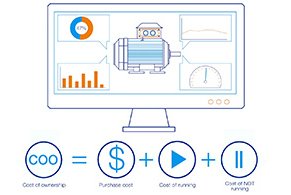Cost of ownership
Why knowing the true cost of ownership of your process can help avoid catastrophic failure
As engineers, one of the most important challenges we face is the need to ensure that our production – whether that be an entire process line or an individual pump or fan - is running at its most efficient. Clues that things may not be running smoothly could be an excessively high energy bill, or the fact that the maintenance team are forever being called to check various aspects of the system.
Worse still is the threat that something more sinister is about to happen; a breakdown so catastrophic that production totally stops. What impact would that have on the environment? What fines would be imposed by the authorities? What would be the impact on the company’s reputation among its customers?”
What you may not be aware of is that each scenario above revolves around two very different cost considerations: the cost of running and the cost of NOT running, let’s say, the pump system. These two aspects, together with the purchase price, make up the “cost of ownership” of the pump system.
The cost of running comprises associated energy costs and the costs of operating and maintaining the pump and motor, including clearing blocked or clogged pumps along with replacing worn or broken parts such as seals, bearings or eroded impellors. Maintenance costs can also cover major overhauls undertaken to extend the useful life of the systems.
The cost of NOT running is a direct cost to a process such as the impact that a forced outage can have on a company’s brand and image. It can also mean tens, or even hundreds of thousands of dollars for every hour in lost production.
These two costs can be so huge that they dwarf the initial purchase cost.
So, how can we control these costs? A good first step is to invite ABB to undertake an energy and productivity assessment.
The assessment quantifies the value provided by investing in premium, leading-edge technology and the inherent reliability this brings. By using a reputable manufacturer like ABB, you can rest assured that the technology has been thoroughly tested, not only in the laboratory but also, more significantly, in plants and processes around the world. Selecting components with known reliability from a trusted supplier is a good insurance against the cost of NOT running becoming unmanageable.
The assessment also highlights ways to improve the cost of running by looking at how to improve energy efficiency, optimize operating performance and reduce maintenance demands. For instance, a pump system may not be operating anywhere near its best efficiency area. This can cause cavitation and vibration issues resulting in impellor erosion and excessive wear to the bearings and seals.
Often pumps are fixed-speed with the flow being controlled by a mechanical valve. As such, pump flow rates are inefficient and the pump is subjected to unnecessary stresses.
A more efficient approach would be to control the pump’s speed using a variable speed drive (VSD). Apart from eliminating damage, which then lowers the cost of not running by boosting reliability, adjusting the pump’s rotational speed can result in significant energy savings, thereby lowering the cost of running. Although the initial outlay may be higher, a VSD pays for itself many times over, and in a short time, through energy savings and productivity improvements.
For instance, its soft start, smooth process control and safety features play a massive role in improving the overall reliability of the entire process - all of which contributes to a lower cost of running.
It also pays to replace old motors with modern high efficiency ones. This further contributes to energy saving but more importantly, their durable design leads to less downtime which lowers the cost of NOT running. And they pay for themselves surprisingly quickly.
Once the latest technology is in place, it is important that the overall system is looked after. This is the role of a predictive maintenance program.
Being able to predict when critical motors will fail by knowing their actual condition allows you to plan effective maintenance and perform it during scheduled plant outages. For larger motors, there’s a whole package of on- and off-line measurement and analysis which can be employed. These can not only help identify the problems, but also shorten the time taken to fix them, again bringing down the cost of not running.
By sourcing motors and drives from one supplier means that purchasing administration is reduced. Fewer parts need to be stocked and maintenance personnel only need to familiarise themselves with a range from one vendor, further contributing to a lower cost of ownership.
Armed with these various tools and services, you now have the lowest cost of ownership. You have an efficient and reliable system, with the pump operating in its best efficiency area, bringing even higher productivity.
By assessing the cost of ownership as a whole, it is possible to eliminate process interruptions while saving money, and most importantly, gain some valuable peace of mind for you and your employer.
Cr.https://new.abb.com/motors-generators














